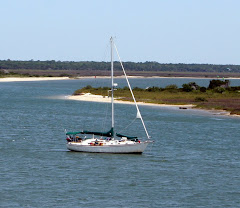
Here's a photo of Jubilee's intrepid team of reporters heading out into the field for more research. They'll stop a nothing to bring you their stories...
The Loggerhead Turtle, by Drew
The Loggerhead Turtle is an endangered species of the Bahamas. It eats mollusks, crab, and jellyfish. They also have powerful jaws and are suited for eating hard shells. These turtles can weigh up to 230 pounds and grow to 43 inches long. They have horned shaped beaks. Loggerhead Turtles live in warm tropical waters around the world and lay eggs on long sandy beaches.
Some threats to Loggerheads are poachers and trash. If one sees a plastic bag it can mistake it for a jellyfish and eat it. Poachers steal eggs and kill the turtles. At the Exuma Land & Sea Park, turtles are being protected to help them come back.
Bahama Hutia, by Emily
A Hutia is a plump, brown, rabbit-sized member of the rodent family. Its weigh is just over a half pound. Hutias are nocternal, so you can't achilly (actually) seee them, but at the Land & Sea Park Office you can see a feac (fake) one.
Hutias are herivores which means plant eaters. They feed on plants and twigs. Hutias live in East Plana Cay, little wax cay and Warderick Wells. Hutias live only these places because they are semi deserts.
Hutias are endangerd species. Bahamaians do worry about hurricanes and birds of prey killing the Hutias, but you can't tell if a hurricane is coming or not to one of the places they live. The End.
West Indian Flamingo, by Jake
The flamingo is the national bird of the Bahamas. It is pink and can get up to four feet tall. It has a slanted down beak and they eat fly eggs. Plus with their slanted down beaks they sand for small tiny shrimp. The shrimp have a chemical called carotene which gives them their color.
Flamingos can fly and when it is mating season they have a dance. The male who is the best dancer is who the female will choose to mate. Flamingos are shy and they live in lonely dry places like Inagua Cay in the Bahamas. Since their nests are on the ground they can be trampled by boars and donkeys. This is why flamingos need to be protected. The End.
IN OUR NEXT ISSUE OF REPORTS FROM THE FIELD... How People Can Help Protect the Plants & Animals of the Bahamas





No comments:
Post a Comment